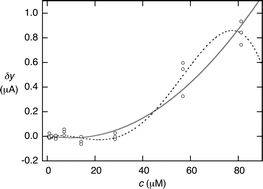Simple algorithms for nonlinear calibration by the classical and standard additions methods†
Abstract
In univariate calibration by both the classical method and the standard additions method, calibration data are fitted to a response function y = f(x), from which the amount of an unknown x0 is estimated by solving an equation of form y0 = f(x0). Most such calibrations are limited to linear response functions f, for which the uncertainty in x0 can be estimated from well-known expressions. The present work describes and illustrates one-step algorithms, in which x0 is treated as an adjustable parameter in a nonlinear fit of the calibration data, with its standard error thus obtained numerically as a direct outcome of the fit. The computations are easily implemented with a number of data analysis programs and are illustrated here for a representative one, KaleidaGraph™. The methods handle heteroscedastic data as easily as homoscedastic and nonlinear functions as easily as linear, permitting the analyst to experiment with different response functions in the quest for an optimum calibration. The estimates of σx0 are obtained from the variance–covariance matrix V for the fit, so for weighted fitting with commercial programs, it is important to know which V—a priori or a posteriori—is being used.


 Please wait while we load your content...
Please wait while we load your content...